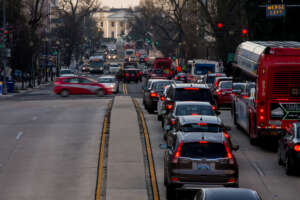

A strike by D.C.-area bus and subway personnel could give opponents of teleworking a taste of what the government would face in the event of a major weather event,...
 A strike by D.C.-area bus and subway personnel could have a major impact on the Trump administration’s plan to drastically reduce teleworking in federal offices around the country. It could give opponents of teleworking a taste of what the government would face in the event of a major weather event, natural disaster or terrorist attack.
A strike by D.C.-area bus and subway personnel could have a major impact on the Trump administration’s plan to drastically reduce teleworking in federal offices around the country. It could give opponents of teleworking a taste of what the government would face in the event of a major weather event, natural disaster or terrorist attack.
Traffic in D.C., with its ubiquitous roundabouts, large diplomatic community, hordes of tourists and 14 percent of the federal workforce is terrible on a good day. If the Metro system goes on strike — a vote authorizing it has already taken place — gridlock extending from the Chesapeake Bay to Harpers Ferry, West Virginia, could be incredible for hundreds of thousands of government workers who live in Maryland, Virginia or the District.
Many Baltimore area feds work in downtown D.C. or Northern Virginia, and for years a group of energetic CIA employees commuted by canoe and kayak from Maryland to the agency’s headquarters in Langley, Virginia. For years, a van pool from Dover, Delaware, made the trip to the Pentagon in Arlington five days a week.
But a growing number of workers in both federal and private sectors get to and from their jobs on the Metro, which includes surface buses and a tri-state subway system that crosses the Potomac River carrying about 1 million people a day, when it’s running, that is. But Metro has been plagued by a series of accidents often blamed on botched or ignored repairs, and now faces the possibility of a strike. An unofficial sick-out last week made commuting a nightmare for one day.
A full blown transit strike in the nation’s third largest system, behind New York City and Chicago, could be a disaster. Union workers had the good PR sense not to strike last Tuesday when the area and its buses, subway cars and parking lots were overflowing because of the MLB All-Star game. It brought a ton of money and people into the city.
But the strike threat is still out there. Whether it happens or not it should and could give pause to officials who are dictating memos to shutdown teleworking opportunities, even as they themselves are chauffeured to and from work, the airport or wherever they go. They use taxpayer-financed limos driven by government chauffers, who in a bipartisan past have been known to drop the bosses offspring at their private schools, or to pick up the bosses dry-cleaning.
Early in the administration it was decided to cut back on the number of teleworking feds from D.C. to Washington state for a variety of reasons. In a government version of “That ’70s Show,” officials questioned the need for, or wisdom of trusting mere bureaucrats to actually work when surrounded by the temptations and comforts of home, daytime TV and chores they didn’t do on weekends. Absent evidence that the employees were binging on soap operas or exercise shows at various federal offices, the departments of Agriculture, and Health and Human Services, for instance, began cutting back on the number of teleworkers and the amount of time they could telework. Federal News Radio has reported that teleworking cutbacks are rumored at the departments of Veterans Affairs and Commerce, as well.
D.C. gets a bum rap for shutting down after winter’s first few snowflakes. But as the primary employer here, and one of the leaders in teleworking, officials often close agencies or curtail hours to keep traffic flowing in this hilly river city with its beautiful but silly traffic circles.
Teleworking has transformed work schedules and habits. Employees authorized to work from home are now automatically expected to man their computers and telephones even as their office mates who aren’t teleworkers get time off if there is a weather emergency or other situation. Cutting back the number of teleworkers could leave vital government operations at risk if there is an extended shutdown for any reason.
A transit strike here could send shock waves to politicians and taxpayers well beyond the Beltway. Maybe it would deliver a message to political appointees that the only thing worse than trusting unsupervised bureaucrats to work from home is having the headquarters personnel of every major federal agency stuck on our infamous Interstate 495, or parked on one of the iconic bridges spanning the Potomac and Anacostia rivers?
By Amelia Brust
Weasels hypnotize their prey with a “dance” of jumping and thrashing, until the target is so mesmerized that it does not see the final, fatal attack.
Source: Nat Geo WILD
Copyright © 2025 Federal News Network. All rights reserved. This website is not intended for users located within the European Economic Area.
Mike Causey is senior correspondent for Federal News Network and writes his daily Federal Report column on federal employees’ pay, benefits and retirement.
Follow @mcauseyWFED

